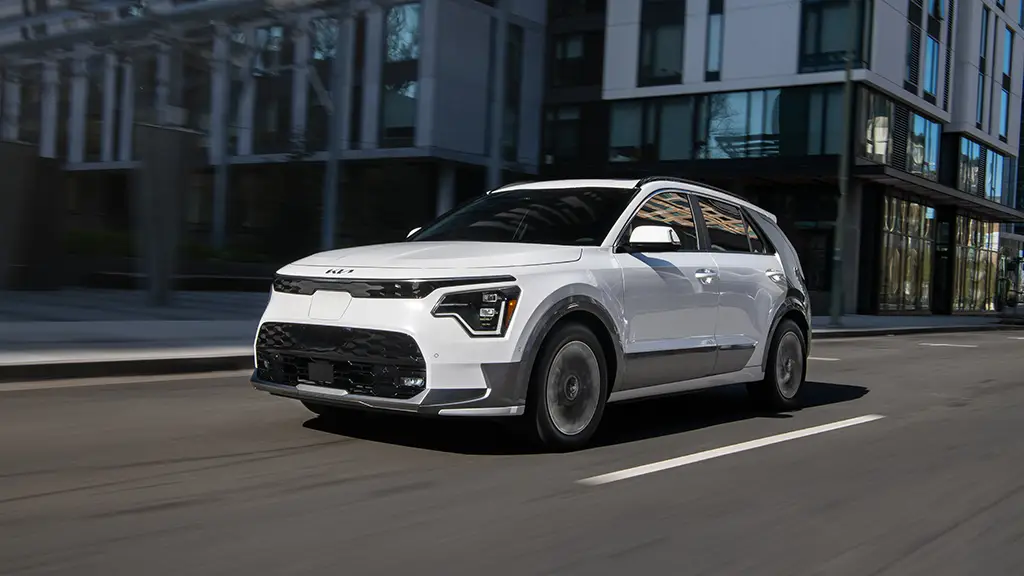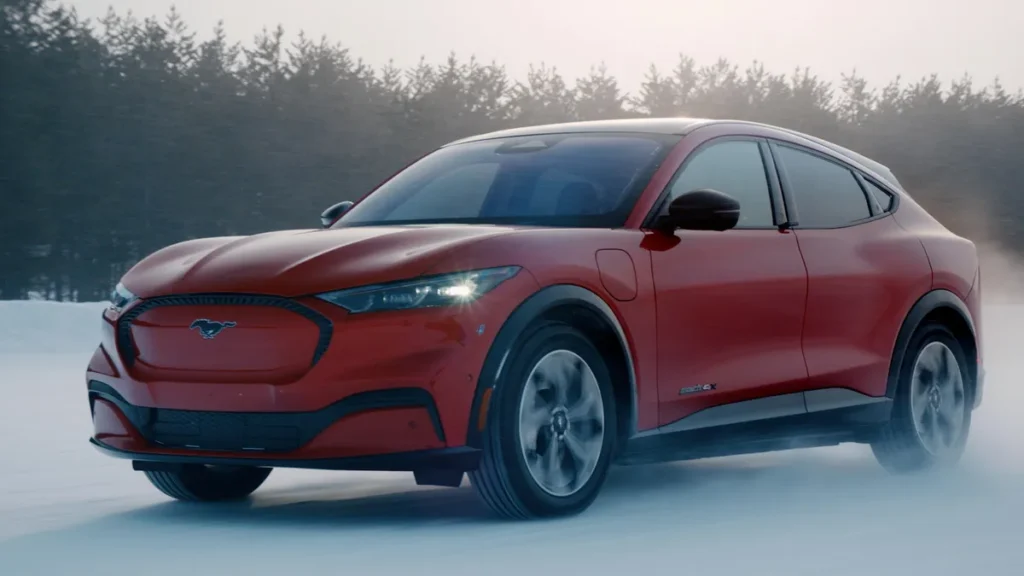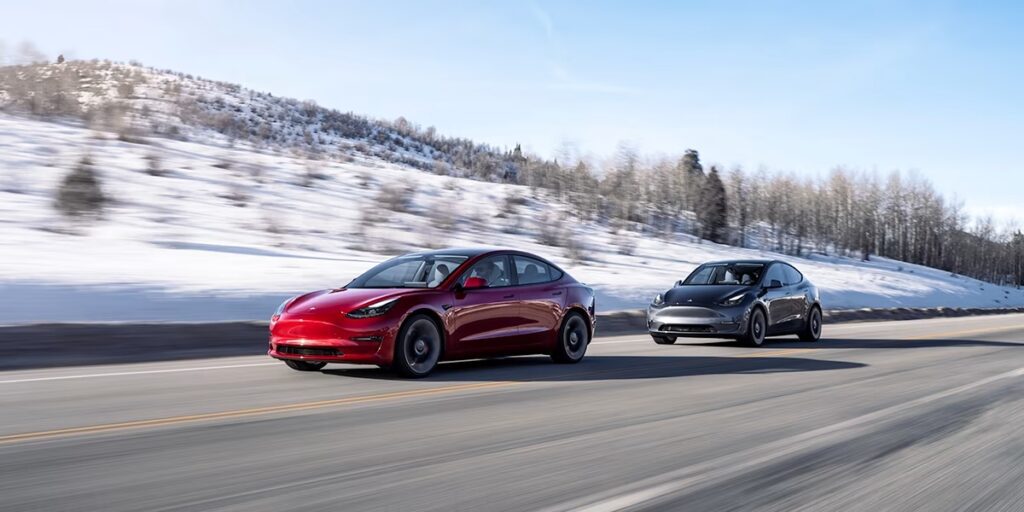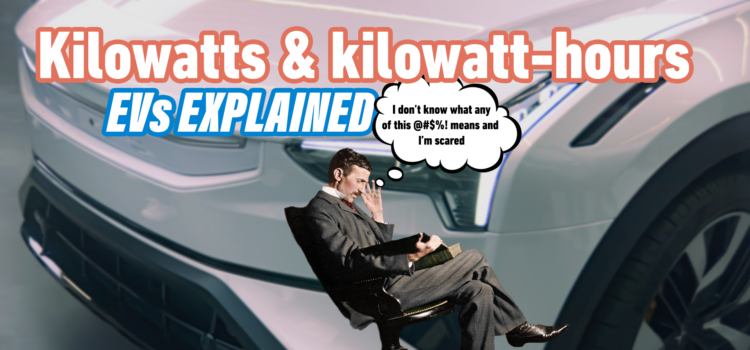The secret to electric car range estimates—and why Tesla always scores big
Welcome to yet another lesson on what’s perhaps the biggest selling point on today’s crop of electric cars: EV range. Yes, everyone would love to have an EV that can keep pace with, if not outlast, their gasser companions on the open road, but what some may not know is that those big ol’ range numbers people use in their games of Top Trumps come from tests. Different tests. Not every EV is held to the same standard and, therefore, can produce wildly varying range numbers in real-world scenarios, oftentimes as a bid to earn the bigger number just to say they can.
Gasp! You mean an automaker can willingly choose a method of range testing if it means being able to advertise that they can wave a bigger stick, even if the product doesn’t necessarily yield the same results in practice? That’s obscene! They would never choose a less honest route just to fluff up their brand image, would they?
Ha! Well, yes. Yes, they can. And they have. Many electric cars have been recorded not to hit their original estimates, and only a few are noted to match or exceed. Tesla and, recently, Lucid have been accused of being the worst offenders in magazine range comparisons, and there’s angst out there regarding it. Enough for me to pen up this EVs Explained piece just to tell you all about the wonderfully riveting world of EV range testing. Don’t get too restless. Like an old compliance car, I won’t take you too far.

[Button id=”478″]
One size fits some
Varying EV range tests have been a thing for some time. Such methodologies include America’s EPA, Europe’s Worldwide Harmonised Light Vehicles Test Procedure (WLTP), Europe’s now-obsolete and unrealistically optimistic New European Driving Cycle (NEDC), and the controversially unrealistic China Light Duty Vehicle Test Cycle (CLTC).
On a recent press launch, I had the opportunity to discuss such varying test methods with Edmunds test editor, Reese Counts, who commented on his Mach-E long-term loaner’s range. And although it didn’t quite hit its EPA estimates, as he commented that almost no electric car does, he does enjoy that it was a very “real” range estimate and didn’t leave him feeling as though a buyer would be conned. As a youngin’ in this field, I asked him what he meant.
Each agency has slightly different testing practices, which already yield different numbers on just the window stickers alone. In America, automakers have a choice of two routes within the EPA’s own set of rules. Because of this, it’s become a clear trend for certain cars from certain brands to come closer to their estimates than others, while others are seemingly blatant lies, except they’re not actual lies. They’re just tested under optimal conditions that favor them. Frequently, it seems these test results can be too optimistic, as seen in some of these big-name magazine range tests, where some cars consistently leave egregious gaps, sometimes as big as 100 miles or more, between their as-tested range and their advertised estimate, like the Tesla Model 3 or Lucid Air in Motor Trend’s recent test.

“They don’t bullshit you,” summarizes Counts regarding automakers with comparatively uninspired range claims for cars that can at least come close in the hands of normal drivers on real roads. Then he recounts cars that willingly choose alternate tests to bolster the range numbers as yet another example of “overselling but underdelivering.”
“Their numbers rarely line up with each other and can also differ from real-world ranges because each organization has its own specific test procedures,” explains Jeremy Laukkonen in a tech explainer for Lifewire. Enough content exists on the internet to explain at least some of those in greater detail, but I’ll summarize them with key highlights as best as I can.
EPA vs. WLTP vs. CLTC range testing
Basically, all EV range tests involve strapping a car down to a dynamometer or dyno, a “rolling road” as they’re sometimes referred to and basically function as a treadmill for cars. The vehicles are then charged to full, left overnight, and run through various cycles to simulate city and highway driving until the batteries can’t power the car. The vehicle is then recharged and run again and again for many tests. EPA and WLTP function similarly but have a few slight twists to them to make their estimates vary.
There’s enough nuance and small details to spin each agency’s test methods off into their own article… which we may actually do at some point. But for now, here are quick, digestible breakdowns of each one.
For greater detail, please consult your doctor (this breakdown by InsideEVs) to see which EV range testing method is right for you (less of a load of crap, in your opinion).
EPA
EPA gives the automakers a choice of a “two-cycle” or “five-cycle” range test, which essentially just dictates how many times the car goes through testing cycles. More on those cycles in a bit, as those are what give us the bigger and smaller gaps in real-world range numbers. City test cycles are conducted for a hair over 11 minutes at a time with a top speed of 56 mph and an average speed of just over 21 mph. Highway test cycles are run for a bit over 10 minutes at an average speed of 48 mpg and a top speed of 60 mph. The combined range figure is estimated by weighing together the city and highway numbers, with city driving accounting for 55% of the score and highway driving for 45%. To further simulate the range-dropping factors of real-world environments, the range is then multiplied by 0.7 to lower it.
In 2008, the EPA added three more cycles an automaker can test for that would better indicate range in real-world conditions, including a 95-degree hot weather test with air-conditioning on, a 20-degree cold weather test, and a high-speed test. Again, the results of using these extra cycles are detailed in a section below, but first, let’s see how they do things across the pond.
WLTP
Like EPA, WLTP uses cycles to test vehicles, but they’re also broken down further into classes based on max speed and power-to-weight ratios. The higher the vehicle’s performance, the higher the test speeds, hence why a Model S Plaid won’t be held to entirely the same standard as, say, a Renault Twizy. A WLTP test will be broken down into Low, Medium, High, and Extra High sub-cycles and run for 30 minutes over 14.4 miles at an average speed of 31 mph and a top speed of over 81.
Unlike the EPA range tests, the lab temperature is static at 73.4 degrees Fahrenheit, and they do not add the 0.7 real-world multiplier to lower the final range numbers. This is partly why EPA numbers are typically lower than their WLTP counterparts. For instance, the combined range of the most frugal Mustang Mach-E in America is rated at 300 miles. Compare that European Mach-E estimates of up to 372. Want another? The refreshed Tesla Model 3 Highland Long Range has a range of 305 to 341 miles, depending on wheel choice, but WLTP estimates peg it between 390 and 421.
Ah yes, the Long Range’s range is indeed long.
CLTC
This is a China-exclusive measure that isn’t necessarily relevant to Western EV buyers unless you enjoy speculating and eyebrow-raising. Criticized as “pushing an EV down a hill in a vacuum,” this methodology has been panned for the same reason as the now-defunct NEDC by producing highly optimistic range figures that may not be anywhere near indicative of what a real-world owner may experience. Unless they apparently push their car down a hill in a vacuum.
This CLTC test is conducted at a constant cruise of 25 mph until the battery goes kaput and is then adjusted for weather, terrain, and other factors via data compiled from real Chinese drivers across its many regions. While yes, this very much plays into an electric car’s inherent lows-speed efficiency and is not quite representative of what Western-driven cars will see, it’s important to remember that this is a Chinese test for Chinese market cars, so EVs are held to a different standard for their own driving environments, which are often dense, slow, and without too much intercity travel on massive high-speed highways.
Two-cycle vs five-cycle range testing

Okay. So, different regions in the world conduct varying range tests and score different figures. Alrighty then, but what about the rampant talk of some brands like Tesla and even Lucid having massive disparities between lab-brewed estimates and real-world numbers?
As Counts explained to me when talking Mach-E numbers, this widdles down to the number of test cycles an automaker chooses to use.
As mentioned, the EPA offers a simple way to test for city and highway ranges with a city and highway cycle. Most automakers opt for this two-cycle test, while a few, particularly smaller startups, opt for the five-cycle test, which, as you can imagine, tests the car over more cycles. As detailed in another InsideEVs piece, it’s not that these companies are conning anyone or cheating a system. They’re just using the options available to them to gain an advantage. Such an advantage yields them a higher number that, therefore, looks better to the press and consumers and puts these startups or anyone else who uses the five-cyle option on a pedestal.
Why is this? Simple.
More cycles let EV makers take advantage of a car’s low-speed efficiency since they’re obviously exerting less energy to move at slower speeds and are bolstered by goodies like regenerative braking. The additional test cycles reportedly also include “high-speed” or aggressive driving, hot weather with air conditioning, and cold weather tests, all of which are done at a low enough speed to work in an electric car’s favor. Cool beans, except when magazines and owners conduct their own independent tests, typically on highways and at far higher speeds than the EPA’s lab experiments. This means the range disparity is, well, to say “noticeable” would be an understatement. Still, this practice of extra low-speed tests is allowed by the EPA and is totally legal, even if it’s not exactly aligned with other automakers’ decisions and doesn’t perfectly convey real-world range results on American roads.
“Such variance. Much wow.”
In case this article, its more detailed source material, and the embedded videos haven’t engrained this into your head by now, there is a mindboggling, brain-jerking, head-spinning array of variance and inconsistencies involved in EV range testing and, by extension, MPGe testing. Not only do global agencies use different methods, but there are also different cycles and sub-cycles within these methods that all yield different results for different cars. On top of that, it doesn’t help that electric vehicles are politically and societally forced to be one of the fastest evolving niches of cars on the road today, with vehicles from several years ago being nearly unrecognizable from a technical perspective from electric cars produced today.
“EVs are one of the fastest-changing areas that we deal with in our laboratory just in terms of how fast this technology is moving,” says engineer, Jarrod Brown, in CNBC’s look at EPA EV testing. “If you look at a vehicle that we had in here even five years ago, a 2016 or 2017 electric vehicle looks almost completely different internally from what we’re seeing in vehicles coming in 2024.”
When testing for range and efficiency, automakers have different ways of recording data for certification, and their cars can all use power differently. One car may not allocate the same energy to running HVAC systems as another, or they may intake and exert electricity to propel the car differently, and so on.
“Every manufacturer kind of has their own way of reporting data on where the power is coming into and going out of the vehicle,” Brown continues regarding the complexity of EV power distribution. “How it’s moving around between the motors and the batteries, or if it’s doing things like regenerative braking, or strategies about how power goes to the heating and cooling system versus how to keep the battery at the right temperature.”




The EPA system, with its many cycles, strives and often succeeds to at least come closest to what consumers can see on their commutes. But this level of added complexity and nonstop evolution may have the current ways of lining up their rulers all tripped up and out of spec. Many critics agree that modern EVs have well outgrown their archaic methods and that a new wave of standardization must come in order to bring realism and uniformity to electric car efficiency measuring.
And if the word is true, change is indeed coming. One popular suggested method is providing city and highway range estimates like how the EPA already does for MPG and MPGe instead of weighing together the two for an average number. That way, consumers know what their best and worst-case scenarios are and don’t take a singular number as the definitive range their cars will always achieve.
Class dismissed
Did I lose you yet? Summary time!
The world has its many ways to measure range, all of which controversially lack a resemblance to real-world range tests, an issue which can be attributed to a variety of reasons, such as different test lengths and speeds, varying methods of averaging out final numbers, or even a lack of air resistance being in a lab strapped to a giant automotive treadmill. Europe currently has WLTP, China has CLTC, and America has the EPA, the latter of which offers a two and five-cycle test for automakers to run their EVs through.

A two-cycle test is a fairly basic test with cycles to simulate city and highway driving. The longer optional five-cycle test introduces high-speed, air-con, and cold tests conducted at fairly low-ish speeds, which works in favor of EV manufacturers since electric cars are incredibly efficient in urban use and deliver the best mileage at slower speeds. This, along with a final range number that favors 55% city and 45% highway driving, makes the five-cycle incredibly alluring to startups like Tesla and Lucid, who claim the biggest numbers in the game yet tend to show the biggest disparity in real-world range come independent tests, which are often done at higher speeds over mostly highway. And while it doesn’t deliver the prettiest, most headline-worthy figures, other automakers opt for the simpler two-cycle test as it yields the more realistic final number that is then more likely to be met by actual owners or at least have come close to.
So go forth and stay educated! And remember this one big takeaway: Like gas mileage, EV range can vary greatly. Everything from weather, road conditions, speed, and HVAC usage can affect your range, and, like these many different magazines, your own electric car’s range may be different from what any agency or even another owner gets. Your driving style may yield a 10-mile range disparity or a 100-mile one. Who knows? Just know that whatever car you buy, whether from some big-name legacy automaker or a fancy-schmancy startup, take those window sticker estimates with a grain of salt.


